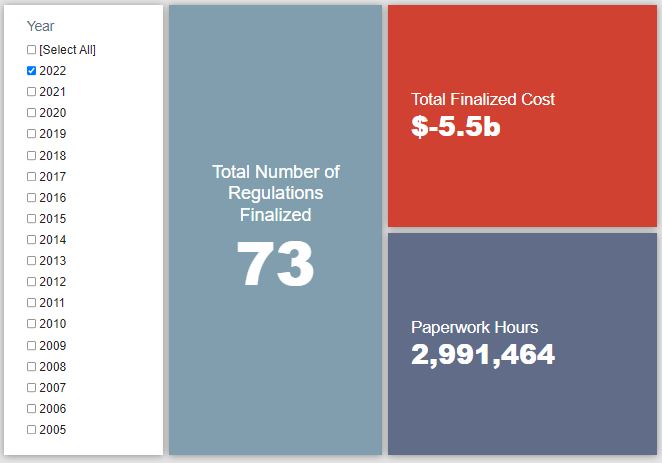Week in Regulation
April 18, 2022
SEC Reclaims the 2022 Regulatory Crown
Despite its domination over the rulemaking activity of 2022’s first quarter, the Securities and Exchange Commission (SEC) had seemingly ceded the regulatory throne to other agencies in recent weeks. This last week saw that brief interregnum come to an end. A controversial SEC proposal that would require extensive “climate risk” disclosures from publicly traded companies officially hit the Federal Register and allowed the agency to reclaim credit for the costliest rulemaking of the year thus far. Across all rulemakings, agencies published $20 billion in total net costs and added 24.7 million annual paperwork burden hours.
REGULATORY TOPLINES
- Proposed Rules: 50
- Final Rules: 63
- 2022 Total Pages: 22,778
- 2022 Final Rule Costs: -$5.5 billion
- 2022 Proposed Rule Costs: $68.2 billion
NOTABLE REGULATORY ACTIONS
The most significant rulemaking of the week – by orders of magnitude – was the SEC proposed rule entitled “The Enhancement and Standardization of Climate-Related Disclosures for Investors.” At its broadest level, the proposal “would require information about a registrant’s climate-related risks that are reasonably likely to have a material impact on its business, results of operations, or financial condition.” A deeper breakdown of the potentially required points of information can be found here.
The estimated administrative burdens involved are quite substantial. SEC calculates that complying with the proposed rule would involve nearly 24.7 million additional hours of paperwork each year, with associated costs of roughly $6.4 billion. For reference, the current administrative burdens for the relevant forms to which SEC would append these requirements add up to merely 18.8 million hours and $3.9 billion in costs. These new burdens represent 131 percent and 164 percent increases over current regulatory baselines, respectively. Extending the annual cost figure across the three-year period in which paperwork requirements are officially approved yields approximately $19.1 billion in total costs, good enough for pole position among all rulemakings thus far into 2022.
TRACKING THE ADMINISTRATIONS
As we have already seen from executive orders and memos, the Biden Administration will surely provide plenty of contrasts with the Trump Administration on the regulatory front. And while there is a general expectation that the new administration will seek to broadly restore Obama-esque regulatory actions, there will also be areas where it charts its own course. Since the American Action Forum (AAF) RegRodeo data extend back to 2005, it is possible to provide weekly updates on how the top-level trends of President Biden’s regulatory record track with those of his two most recent predecessors. The following table provides the cumulative totals of final rules containing some quantified economic impact from each administration through this point in their respective terms.
![]()
With the main regulatory actions of the week coming on the proposed rule side, there was virtually no movement in the Biden Administration’s running final rule totals. There were, however, some notable shifts around this time in the other covered administrations. The Trump Administration saw a roughly $300 million decrease in its regulatory cost total, driven primarily by a deregulatory Department of Labor rule. Meanwhile, the Obama Administration saw a substantial upward spike in both regulatory costs and paperwork totals, increasing by $1.8 billion and nearly 6 million hours, respectively. This final rule regarding changes to Medicare Advantage provided the bulk of those increases.
THIS WEEK’S REGULATORY PICTURE
This week, the Department of Justice (DOJ) takes aim at ghost guns.
On April 11, President Biden announced at an event at the White House that DOJ would soon publish a final rule expanding the definition of firearms to include privately made firearms and gun kits.
The newly covered weapons are commonly referred to as ghost guns, since they are difficult to trace because they previously were not required to have serial numbers. The final rule requires kits sold commercially that can be readily assembled by a purchaser to have serial numbers. In addition, if a gun retailer buys a firearm without a serial number from a gun owner, the retailer must serialize the gun before reselling it. In addition to the serial number requirements, the rule requires gun kit retailers to conduct background checks.
The rule also amends recordkeeping requirements to obligate retailers of all firearms to keep records for as long as they are licensed to sell, up from the previous minimum of 20 years.
DOJ cited rising prevalence of ghost guns, and their increased use in violent crimes, as justification for the new rule. According to DOJ, the number of suspected ghost guns recovered has increased from less than 1,800 in 2016 to more than 19,000 in 2021. The challenge for law enforcement, according to DOJ, is that since the weapons lack serial numbers, they are extremely difficult to trace back to owners when conducting criminal investigations. In addition, since they were previously not subject to background checks, the weapons are more likely to end up in the hands of those who could not pass federal checks. The DOJ estimates that the new rule will lead to approximately 1,000 additional guns recovered in investigations per year. The agency also estimates the rule will cost an estimated $14.3 million annually and will take effect 120 days after it is published in the Federal Register.
The rule is not without opposition. By the end of the week, four Republican senators announced they would file a Congressional Review Act resolution in a longshot attempt to nullify the rule.
TOTAL BURDENS
Since January 1, the federal government has published $62.7 billion in total net costs (with $5.5 billion in new cost savings from finalized rules) and 45.1 million hours of net annual paperwork burden increases (with 3 million hours in increases from final rules).












